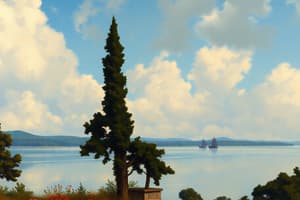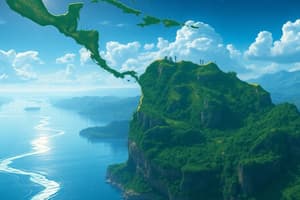Podcast
Questions and Answers
Match each North American location with its correct description:
Match each North American location with its correct description:
Yellowstone National Park = Open active geological features such as hot springs and geysers. Pacific Northwest Rain Forests = Lush ferns and tall evergreen forests with cedar, spruce, and fir trees. Canadian Shield = Rock base with lakes and marshes sculpted by glacial retreat during the Ice Age. Grand Canyon = 1,800-meter deep canyon formed by water erosion from the Colorado River. Columbia Ice Fields = One of the largest glaciers in the Canadian Rockies and the source of the Columbia River. Mt. Denali = The highest peak in North America, standing at 6,190 meters.
Which of the following best describes the climate of Central American countries like Belize, Guatemala, and Costa Rica?
Which of the following best describes the climate of Central American countries like Belize, Guatemala, and Costa Rica?
- Temperate climate with distinct seasons
- Tropical climate (correct)
- Alpine climate with cold temperatures
- Arid desert climate
Mexico's eastern coast is more prone to tropical storms than its western coast.
Mexico's eastern coast is more prone to tropical storms than its western coast.
True (A)
What natural process primarily formed the Grand Canyon?
What natural process primarily formed the Grand Canyon?
The Columbia Ice Fields are located in Banff National Park in __________, Canada.
The Columbia Ice Fields are located in Banff National Park in __________, Canada.
Which geographical feature allows ships to pass from the Caribbean Sea to the Pacific Ocean?
Which geographical feature allows ships to pass from the Caribbean Sea to the Pacific Ocean?
All of Canada lies within the Arctic Circle.
All of Canada lies within the Arctic Circle.
What is the name given to the countries located south of Mexico on the North American continent?
What is the name given to the countries located south of Mexico on the North American continent?
The ________ is a large sheet of rock stretching from Eastern Canada to the Arctic regions, limiting farming due to long winters.
The ________ is a large sheet of rock stretching from Eastern Canada to the Arctic regions, limiting farming due to long winters.
Which of the following factors is NOT a significant influence of the earth's tilt?
Which of the following factors is NOT a significant influence of the earth's tilt?
Match the territory/country with the body of water that primarily borders it to the north:
Match the territory/country with the body of water that primarily borders it to the north:
Why is farming limited in the Canadian Shield region?
Why is farming limited in the Canadian Shield region?
The North Pole is located at $66°34'$ North latitude.
The North Pole is located at $66°34'$ North latitude.
Which of the following factors contributes most to the fertile farming conditions in Southern Ontario and Quebec, compared to areas further north?
Which of the following factors contributes most to the fertile farming conditions in Southern Ontario and Quebec, compared to areas further north?
The Appalachian Mountain range stretches from the Northeast to the South, eventually transitioning into a coastal plain that extends to the Pacific Ocean.
The Appalachian Mountain range stretches from the Northeast to the South, eventually transitioning into a coastal plain that extends to the Pacific Ocean.
Name a mountain range that has some of the highest mountain peaks in North America.
Name a mountain range that has some of the highest mountain peaks in North America.
The Great Plains, known for their rich agricultural area, extend from Southern Canada down through the middle of the United States to the Gulf of ______.
The Great Plains, known for their rich agricultural area, extend from Southern Canada down through the middle of the United States to the Gulf of ______.
Match the following regions with their described climate or geographical feature:
Match the following regions with their described climate or geographical feature:
Which of these locations was home to some of Mexico's earliest civilizations, specifically the Olmec and Mayan?
Which of these locations was home to some of Mexico's earliest civilizations, specifically the Olmec and Mayan?
The Western United States is divided from which of the following landforms by the Rocky Mountains?
The Western United States is divided from which of the following landforms by the Rocky Mountains?
The continental area of the United States has a western seaboard that borders the icy waters of the North Atlantic.
The continental area of the United States has a western seaboard that borders the icy waters of the North Atlantic.
Flashcards
Mexico's Pacific Coast
Mexico's Pacific Coast
The western border of Mexico, known for its drier climate and protection from Gulf of Mexico tropical storms.
Central America's Climate
Central America's Climate
Belize, Guatemala, El Salvador, Honduras, Costa Rica and Panama share this type of warm, wet weather pattern.
Yellowstone National Park
Yellowstone National Park
A USA park famous for geological features like geysers and hot springs.
The Grand Canyon
The Grand Canyon
Signup and view all the flashcards
Mt. Denali (Mt. McKinley)
Mt. Denali (Mt. McKinley)
Signup and view all the flashcards
Caribbean Islands
Caribbean Islands
Signup and view all the flashcards
Southern Ontario and Quebec
Southern Ontario and Quebec
Signup and view all the flashcards
Canadian Rockies/Denali Range
Canadian Rockies/Denali Range
Signup and view all the flashcards
Appalachian Mountains
Appalachian Mountains
Signup and view all the flashcards
Great Plains
Great Plains
Signup and view all the flashcards
Rocky Mountains
Rocky Mountains
Signup and view all the flashcards
Yucatan Peninsula
Yucatan Peninsula
Signup and view all the flashcards
Sierra Madre Occidental
Sierra Madre Occidental
Signup and view all the flashcards
Largest North American countries?
Largest North American countries?
Signup and view all the flashcards
Panama Canal
Panama Canal
Signup and view all the flashcards
The Great Lakes
The Great Lakes
Signup and view all the flashcards
Sierra Madre Occidental Mountains
Sierra Madre Occidental Mountains
Signup and view all the flashcards
Central America
Central America
Signup and view all the flashcards
Arctic Circle
Arctic Circle
Signup and view all the flashcards
Canadian Shield
Canadian Shield
Signup and view all the flashcards
Study Notes
- There are ten countries on the continent of North America.
- There are about 13 different nations and territorial islands in the Caribbean Sea.
- The lesson focuses on the three largest continental nations: Canada, the United States, and Mexico.
- Belize, Honduras, Guatemala, El Salvador, Nicaragua, Costa Rica, and Panama are the four other countries on the North American continent to the south of Mexico, and are often referred to as Central America.
- The Panama Canal was constructed and opened in 1914.
- The Panama Canal allows ships to pass from the Caribbean Sea on the Atlantic Ocean side to the Pacific Ocean.
- Panama is the end point of North America and where South America begins.
- The island nations in the Caribbean Sea, include the larger island countries of Cuba, Haiti, the Dominican Republic, and Jamaica.
- Smaller island nations are in the Caribbean Sea along with islands that are territories of other countries including Puerto Rico, the U.S. Virgin Islands, and the British Virgin Islands.
- The northernmost parts of North America include Canada and the US state of Alaska.
- Some parts of Canada lie within the Arctic Circle at 66°34′ North latitude.
- All land remains in polar darkness during the winter months peaking on December 22nd, winter solstice.
- The same areas stay in constant sunlight for six months of the year, peaking on June 21st, the summer solstice.
- The Earth's axis tilts toward and away from the sun, causing variation in sunlight.
- The frozen Arctic Ocean and the North Pole at 90° North are located to the north of Canada.
- The Canadian Shield is a large sheet of rock that stretches from the St. Lawrence River in Eastern Canada to the Great Lakes in Southern Canada and northward up to the Arctic regions.
- Farming is limited in this region because the winters are long.
Land Below the Arctic Circle
- Most people in Eastern Canada live below the Arctic circle in Southern Ontario and Quebec along the Great Lakes and St. Lawrence Rivers.
- Above the Arctic circle, the winter is shorter, the climate is warmer, and the topsoil is deeper, making the land more fertile for farming.
- The Canadian Rockies and the Denali Range in Alaska have the highest mountain peaks in North America.
- The continental area of the United States has an Eastern seaboard that borders the cold and icy waters of the North Atlantic, with cold winters and hot and humid summers.
- The southeastern coastal areas have moderate winters and longer hot humid summers.
- The areas of southern Florida have subtropical weather.
- The Appalachian Mountain range stretches from the Northeast to the South, where it runs into a large coastal plain that spans from the Atlantic Ocean across the northern areas of the Gulf of Mexico into the Great Plains.
- The Great Plains are a rich agricultural area with topsoil extending from Southern Canada down through the middle of the United States to the Gulf of Mexico.
- The Western United States is divided from the Great Plains by the Rocky Mountains.
- Northern California has long agricultural valleys and forests that stretch up the northwest coastal mountain ranges with the Cascade Mountain Range extending toward British Columbia in Canada.
- The upper areas of the Northwest are quite wet with rain forests and a large amount of precipitation from rain.
- The rest of the Far West has a dry climate with extreme cold winters in the northern areas near the Rocky Mountains, but hot and dry summers.
- The Southwestern United States remains hot and dry through most of the year.
- The Central Mexican Plateau is in the southern half of North America, and has rich valleys set between the long Sierra Madre Occidental Mountain range and volcanic mountains that surround the great plain of Mexico City.
- Mexico's eastern coastline borders the Gulf of Mexico.
- The Yucatan Peninsula in Mexico's Southeast was the location of many of Mexico's earliest sites of civilization belonging to the Olmec and Mayan civilizations.
- Mexico's western coast borders the Pacific Ocean where the climate is drier and sheltered from tropical storms that arise seasonally in the Gulf of Mexico.
- The Central American countries of Belize, Guatemala, El Salvador, Honduras, Costa Rica and Panama are smaller in size and have a tropical climate.
Natural Features
- Yellowstone National Park in Wyoming, United States has active geological features such as hot springs, natural geysers, and mineral pools such as the Grand Prismatic Pool.
- The rain forests of the Pacific Northwest contain lush ferns and other plant life as ground cover and tall evergreen forests with cedar, spruce, and fir trees; such as Macmillan Provincial Park in British Columbia.
- The Canadian Shield is a rock base with lakes and marshes in this northern landscape that glaciers sculpted during the Ice Age about 200,000 years ago.
- The Grand Canyon is a 1,800-meter deep canyon in Arizona, formed by water erosion from the Colorado River.
- The Columbia Ice Fields in Banff National Park in Alberta, Canada is one of the largest glaciers in the Canadian Rockies; source of the Columbia River, which stretches 2,000 km from Canada to Washington and Oregon on the Pacific Ocean.
- Mt. Denali, in Alaska, also referred to as Mt. McKinley, is 6,190 meters tall and the highest peak in North America.
Studying That Suits You
Use AI to generate personalized quizzes and flashcards to suit your learning preferences.




